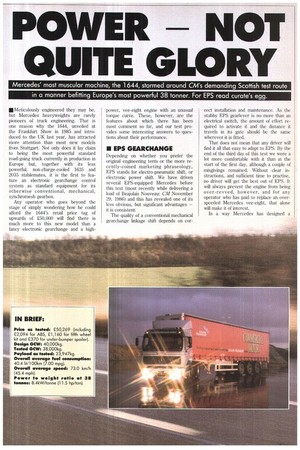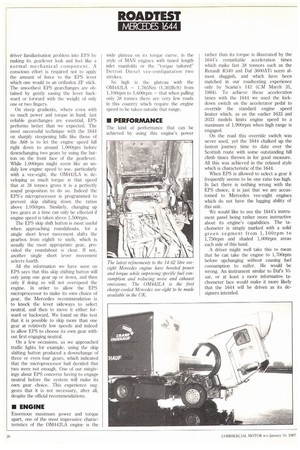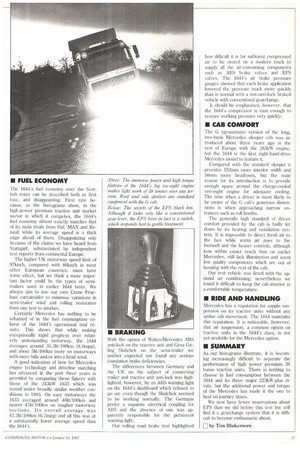POWER NOT QUITE GLORY
Page 27

Page 28

Page 29

If you've noticed an error in this article please click here to report it so we can fix it.
Mercedes' most muscular machine, the 1644, stormed around CA4`s demanding Scottish test route in a manner befitting Europe's most powerful 38 tonner. For EPS read curate's egg.
/Meticulously engineered they may be, but Mercedes heavyweights are rarely pioneers of tnick engineering. That is one reason why the 1644, unveiled at the Frankfurt Show in 1985 and introduced to the UK last year, has attracted more attention than most new models from Stuttgart. Not only does it lay claim to being the most powerful standard road-going truck currently in production in Europe but, together with its less powerful, non-charge-cooled 1635 and 2035 stablemates, it is the first to feature an electronic gearchange control system as standard equipment for its otherwise conventional, mechanical, synchromesh gearbox.
Any operator who goes beyond the stage of simply wondering how he could afford the 1644's retail price tag of upwards of £.50,000 will find there is much more to this new model than a fancy electronic gearchange and a high
power, vee-eight engine with an unusual torque curve. These, however, are the features about which there has been most comment so far, and our test provides some interesting answers to questions about their performance.
• EPS GEARCHANGE
Depending on whether you 'prefer the original engineering term or the more recently-coined marketing phraseology, EPS stands for electro-pneumatic shift, or electronic power shift. We have driven several EPS-equipped Mercedes before this test (most recently while delivering a load of Beajolais Nouveau: CM November 29, 1986) and this has revealed one of its less obvious, but significant advantages — it is consistent.
The quality of a conventional mechanical gearchange linkage shift depends on cor
rect installation and maintenance. As the stubby EPS gearlever is no more than an electrical switch, the amount of effort required to activate it and the distance it travels in its gate should be the same wherever it is fitted.
That does not mean that any driver will find it all that easy to adapt to EPS. By the end of the third day of this test we were a lot more comfortable with it than at the start of the first day, although a couple of misgivings remained. Without clear instructions, and sufficient time to practise, no driver will get the best out of EPS. It will always prevent the engine from being over-revved, however, and for any operator who has paid to replace an overspeeded Mercedes vee-eight, that alone will make it of interest.
In a way Mercedes has designed a driver familiarisation problem into EPS by making its gearlever look and feel like a normal mechanical component. A conscious effort is required not to apply the amount of force to the EPS lever which one would to an orthodox ZF stick. The smoothest EPS gearchanges are obtained by gently easing the lever backward or forward with the weight of only one or two fingers.
On steep gradients, where even with so much power and torque in hand, fast reliable gearchanges are essential, EPS performs better than we expected. The most successful technique with the 1644 on sharply steepening hills like those of the A68 is to let the engine speed fall right down to around 1,000rpm before downchanging two gears by using the button on the front face of the gearlever. While 1,000rpm might seem like an unduly low engine speed to use, particularly with a we-eight, the 0M442LA is developing so much torque at that speed that at 38 tonnes gross it is a perfectly sound proposition to do so. Indeed the EPS's microprocessor is programmed to prevent skip shifting down the ratios above 1,050rprn. Similarly, changing up two gears at a time can only be effected if engine speed is taken above 1,500rpm.
The EPS skip shift button is most useful when approaching roundabouts, for a single short lever movement shifts the gearbox from eighth to sixth, which is usually the most appropriate gear, provided the roundabout is clear. If not, another single short lever movement selects fourth.
All the information we have seen on EPS says that this skip shifting button will only jump one gear up or down, and then only if doing so will not overspeed the engine. In order to allow the EPS microprocessor to make its own choice of gear, the Mercedes recommendation is to knock the lever sideways to select neutral, and then to move it either forward or backward. We found on this test that it is possible to skip more than one gear at relatively low speeds and indeed to allow EPS to choose its own gear without first engaging neutral.
On a few occasions, as we approached traffic lights for example, using the skip shifting button produced a downchange of three or even four gears, which indicated that the microprocessor had decided that two were not enough. One of our misgiv ings about EPS concerns having to engage neutral before the system will make its own gear choice. This experience suggests that it is not necessary, after all, despite the official recommendations.
• ENGINE
Enormous maximum power and torque apart, one of the most impressive characteristics of the 0M442LA engine is the wide plateau on its torque curve, in the style of MAN engines with tuned length inlet manifolds or the "torque tailored" Detroit Diesel vee-configuration two strokes.
So high is the plateau with the 0M442LA — 1,765Nin (1,3021b/ft) from 1,100rpm to 1.600rprn — that when pulling only 38 tonnes there are very few roads in this country which require the engine speed to be taken outside that range.
• PERFORMANCE
The kind of performance that can be achieved by using this engine's power rather than its torque is illustrated by the 1644's remarkable acceleration times which make fast 38 tonners such as the Renault R340 and Daf :3600ATi seem almost sluggish, and which have been matched in our roadtesting experience only by Scania's 142 (CM March 31, 1984). To achieve these acceleration times with the 1644 we used the kickdown switch on the accelerator pedal to override the standard engine speed limiter which, as on the earlier 1633 and 2033 models limits engine speed to a maximum of 1,900rpm when high range is engaged.
On the road this override switch was never used, yet the 1644 chalked up the fastest journey time to date over the Scottish route with some outstanding hill climb times thrown in for good measure. All this was achieved in the relaxed style which is characteristic of the 1644.
When EPS is allowed to select a gear it frequently seems to be one ratio too high. in fact there is nothing wrong with the EPS choice, it is just that we are accustomed to Mercedes vee-eight engines which do not have the lugging ability of this unit.
We would like to see the 1644's instrument panel being rather more instructive about its engine's capabilities. The tachometer is simply marked with a solid green segment from 1,1 0Orpm to 1,750rpm and shaded 1,000rpm areas each side of this band.
A driver might well take this to mean that he can take the engine to 1,700rpm before upchanging without causing fuel consumption to suffer. He would be wrong. An instrument similar to Dal's Visar, or at least a more informative tachometer face would make it more likely that the 1644 will be driven as its designers intended.
• FUEL ECONOMY
The 1644's fuel economy over the Scottish route can be described both as first rate, and disappointing. First rate because, as the histograms show, in the high-power premium tractive unit market sector in which it competes, the 1644's fuel economy almost exactly matches that of its main rivals from Dal, MAN and Renault while its average speed is a thick edge ahead of them. Disappointing only because of the claims we have heard from Stuttgart. substantiated by independent test reports from continental Europe.
The higher UK motorway speed limit of 97km/h, compared with 80km/h in most other European countries, must have some effect, but we think a more important factor could be the types of semitrailers used in earlier 1644 tests. We always aim to use our own Crane Fruehauf curtainsider to minimise variations in semi-trailer wind and rolling resistance from one test to another.
Certainly Mercedes has nothing to be ashamed of in the fuel consumption column of the 1644's operational trial results. This shows that while making exceptionally rapid progress over relatively undemanding motorway, the 1644 averages around 35.31it/100km (8.0mpg), and about 51it/100km more on motorways with more hills and/or into a head wind.
A good indication of how far Mercedes engine technology and driveline matching has advanced in the past three years is provided by comparing these figures with those of the 243kW 1633 which was tested under broadly similar weather conditions in 1983. On easy motorways the 1633 averaged around 401it/100km and nearer 471it/100km on tougher motorway sections. Its overall average was 42.21it/100km (6.7mpg) and all this was at a substantially lower average speed than the 1644's. Above: The imnwnse power and high torque plateau of the 1644's big vee-eight engine makes light work of 38 tonnes over any terrain. Roof and side spoilers are standard equipment with the G cab.
Below: The secrets of the EPS black box. Although it looks very like a conventional gear lever, the EPS lever in fact is a switch, which responds best to gentle treatment.
• BRAKING
With the option of Wabco/Mercedes ABS anti-lock on the tractive unit and Grau Girling Skidchek on the semi-trailer we neither expected nor found any serious foundation brake deficiencies.
The differences between Germany and the UK on the subject of connecting trailer and tractive unit anti-lock was highlighted, however, by an ABS warning light on the 1644's dashboard which refused to go out even though the Skidchek seemed to be working normally. The Germans prefer a separate electrical coupling for ABS and the absence of one was apparently responsible for the persistent warning light.
Our rolling road brake test highlighted how difficult it is for sufficient compressed air to be stored on a modern truck to supply all the air-consuming components such as ABS brake valves and EPS valves. The 1694's air brake pressure gauges showed that each brake application lowered the pressure much more quickly than is normal with a non-anti-lock braked vehicle with conventional gearchange.
It should be emphasised, however, that the 1644s compressor is man enough to restore working pressure very quickly.
• CAB COMFORT
The G (grossrauin) version of the long, two-bunk Mercedes sleeper cab was introduced about three years ago in the rest of Europe with the 283kW engine. but the 1644 is the first right-hand-drive Mercedes model to feature it.
Compared with the standard sleeper it provides 152nun more interior width and 50mm more headroom, but the main reason for its introduction is to provide enough space around the charge-cooled vee-eight engine for adequate cooling. The time when a driver is most likely to be aware of the G cab's generous dimensions is when approaching narrow entrances such as toll booths.
The generally high standard of driver comfort provided by the cab is badly let down by its heating and ventilation system. It is impossible to direct fresh air to the face while warm air goes to the footwell and the heater controls, although now within easier reach than on earlier Mercedes, still lack illumination and seem low quality components which are out of keeping with the rest of the cab.
Our test vehicle was fitted with the optional air conditioning; nevertheless we found it difficult to keep the cab interior at a comfortable temperature.
• RIDE AND HANDLING
Mercedes has a reputation for supple suspension on its tractive units without any undue cab movement. The 1644 maintains this reputation. It is noticeable, however, that air suspension, a common option on tractive units in the I644's class, is not yet available for the Mercedes option.
• SUMMARY
As our histograms illustrate, it is becoming increasingly difficult to separate the performance of high power premium 38 tonne tractive units. There is nothing to choose in fuel consumption between the 1644 and its three major 223kW-plus rivals, but the additional power and torque of the Mercedes has made it the one to beat on journey times.
We now have fewer reservations about EPS than we did before this test but still find it a gearchange system that it is difficult to become enthusiastic about.
by Tim Blakemore




































































